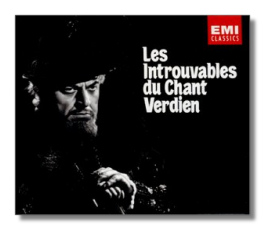
The Internet's Premier Classical Music Source
Related Links
- Verdi Reviews
- Latest Reviews
- More Reviews
-
By Composer
-
Collections
DVD & Blu-ray
Books
Concert Reviews
Articles/Interviews
Software
Audio
Search Amazon
Recommended Links
Site News
 CD Review
CD Review
Giuseppe Verdi

Les Introuvables du Chant Verdien
- 136 selections recorded between 1903 and 1954 from Ernani, Il trovatore, Macbeth, Rigoletto, Simon Boccanegra, La traviata, Nabucco, La forza del destino, Don Carlo, I vespri siciliani, I lombardi, Aïda, I due Foscari, Otello, Luisa Miller, Un ballo in maschera, and Falstaff
EMI Classics 74217 ADD monaural 8CDs: 74:33, 72:14, 73:13, 71:09, 71:39, 72:53, 69:48, 74:01
Wow! This is the best commemorative CD release thus far in the hundredth year since Giuseppe Verdi's death. Originally, it was released in 1986 on eight LPs; now, for the CD reissue, producer and transfer engineer Keith Hardwick has taken advantage of the medium's capacities by adding many selections not found in the original set. The result is an unforgettable feast for Verdians and for lovers of vintage vocal recordings alike.
Most of the best-known singers from the first half of the twentieth century are included here. Among the sopranos, you will find Nellie Melba, Amelita Galli-Curci, Rosa Ponselle, Claudia Muzio, and Elisabeth Schwarzkopf. (Surprisingly, Maria Callas is absent, although Hardwick reminds us that these are introuvables or hard to find recordings, and Callas hardly has been forgotten in the CD era.) Other prominent female singers who appear in this collection are Louise Homer, Clara Butt, Ebe Stignani, and Fedora Barbieri. The famous tenors include Enrico Caruso, Beniamino Gigli, Tito Schipa, Jussi Björling, and Giuseppe di Stefano; lower-voiced representatives include Mattia Battistini, Giuseppe de Luca, Ezio Pinza, Boris Christoff, and Tito Gobbi.
What makes this collection truly remarkable, however, are the singers whose names are known only to a handful of specialists. Turn your attention, then, to Olimpia Boronat, who sings "Tutte le feste" from Rigoletto (1908) with heartbreaking yet girlish intensity, or, from the same opera, "Caro nome" (1914, and in Russian!) sung Lydia Lipkowska, whose plangent coloratura establishes a vivid character even through the limitations of the recording medium. (And, compare Lipkowska's "Caro nome" to Maria Ivogün's even more plaintive 1917 recording of the same music to hear how she creates a completely different character!) Francesco Navarini's 1907 "Il lacerato spirito" (Simon Boccanegra) is utterly imposing and powerfully grieving, and what a voice! Hardwick follows it with Kipnis's 1931 recording – a perfect contrast because of Kipnis's restraint, which is no less effective. Who was Maria Kousnezoff, whose circa 1920 recording of "Ah fors'è lui" (La traviata) distills unbearable longing into three minutes and eight seconds (a questionable high note notwithstanding)? Who was Paul Franz, whose French "Celeste Aïda" (1912) is so sexily heroic? Natalia Yushina? Hertha Stolzenberg? Melanie Kurt? Margarete Arndt-Ober? Paul Payan? Leonce Escalais?
These recordings reflect the traditions of the times. Some of the singers depart significantly from what Verdi wrote. Try, for example, Selma Kurz's 1911 "Saper vorreste" from Un ballo in maschera for whole chains of trills and roulades that gratify her ego (and, to be honest, her willing listeners) but not the composer. Words cannot describe Clara Butt's truncated 1915-16 "O don fatale" (Don Carlos), an exciting battle between her low and high registers, which seem to belong to two different people. Today's singers, for better or worse, wouldn't dare to sing like this. Unfortunately, many of them couldn't do it if they tried. Even while one is scandalized by some of the more "incorrect" interpretations in this collection, one usually can't help being mightily impressed.
Intelligently, Hardwick has grouped the selections by opera, not in chronological order, and not by voice. Disc Two, for example, contains 16 selections from Rigoletto, ranging from Alfred Piccaver's 1912 "Questa o quella" to Titta Ruffo and Graziella Pareto's 1908 recording of the final scene. In effect, one gets a potted version of the opera, and aural fatigue is avoided by varying voice types, as well as by breaking up blocks of more difficult acoustic recordings with electric ones. The transfers make use of the most modern technologies. Pitches have been corrected (Hardwick reminds us that "78-rpm" records frequently were cut at higher or lower speeds, and that speeds could vary even over the course of a single side.) Computer technology has allowed Hardwick to minimize surface noise, thereby allowing the music on even the most faded acoustic discs to jump out into high relief.
The booklet contains a track listing (with recording dates/locales and matrix numbers), photos of some of the singers (not always well reproduced) and essays by Hardwick (in English and German) and André Tubeuf. Finally, it should be noted that this expanded edition of Verdian introuvables has been made possible by the inclusion of recordings currently under the control of Polydor, Teldec, and RCA. Thanks to them! Also, if one has enjoyed this set, which deserves to win many awards this year, there are similar sets of introuvables devoted to Wagner and Mozart singing. They are as enthusiastically recommended as the present one.
Copyright © 2001, Raymond Tuttle




















